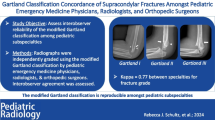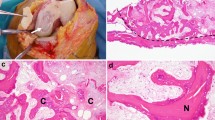Summary
Magnetic resonance imaging (MRI) of normal fracture repair was evaluated in six randomly chosen adult patients with solitary, closed fractures of the tibial shaft by obtaining serial MRI scans until union of the fracture. The mean time to union was 14.3 weeks. Ultralow-field 0.02-Tesla magnet equipment was used. The MRI scans showed a characteristic pattern of events common for all the patients studied and compatible with the recognized histomorphology of fracture repair. The intramedullary cavity demonstrated a marked decrease in the signal intensity. In the soft tissues surrounding the fracture the initially evenly high signal intensity gradually developed a granular appearance with embedded low-intensity nodules. These nodules corresponded to the first areas to become mineralized, as could be seen on plain radiographs several weeks later. The question of whether MRI renders it possible to predict delayed union calls for continued investigations.
Similar content being viewed by others
References
Alanen A (1986) Magnetic resonance imaging of hematomas in a 0.02-T magnetic field. Acta Radiol [Diagn] (Stockh) 27:589–593
Amir D, Schwartz Z, Weinberg H, Sela J (1988) The distribution of extracellular matrix vesicles in healing of rat tibial bone 3 days after intramedullary injury. Arch Orthop Trauma Surg 107:1–6
Atlan H, Sigal R, Hadar H, Chisin R, Cohen I, Lanir A, Soudry M, Machtey Y, Schreiber R, Benmair J (1986) Nuclear magnetic resonance proton imaging of bone pathology. J Nucl Med 27:207–215
Bassett LW, Gold RH, Reicher M, Bennett LR, Tooke SM (1987) Magnetic resonance imaging in the early diagnosis of ischemic necrosis of the femoral head. Preliminary results. Clin Orthop 214:237–248
Böstman O, Hänninen A (1982) Tibial shaft fractures caused by indirect violence. Acta Orthop Scand 53:981–990
Ehman RL, Berquist TH (1986) Magnetic resonance imaging of musculoskeletal trauma. Radiol Clin North Am 24: 291–319
Gregg PJ, Barsoum MK, Clayton CB (1983) Scintigraphic appearance of the tibia in the early stages following fracture. Clin Orthop 175:139–146
Haines JF, Williams EA, Hargadon EJ, Davies DRA (1984) Is conservative treatment of displaced tibial shaft fractures justified? J Bone Joint Surg [Br] 66:84–88
Hammer RR, Hammerby S, Lindholm B (1985) Accuracy of radiologic assessment of tibial shaft fracture union in humans. Clin Orthop 199:233–238
Koenig H, Lucas D, Meissner R (1986) The wrist: a preliminary report on high-resolution MR imaging. Radiology 160:463–467
Laasonen EM, Porras M (1983) Post-traumatic osteomyelitis. Delay in appearance after infection and prognostic value of radiological signs. Eur J Radiol 3:95–96
McKibbin B (1978) The biology of fracture healing in long bones. J Bone Joint Surg [Br] 60:150–162
Mitchell DG, Kressel HY, Arger PH, Dalinka M, Spritzer CE, Steinberg ME (1986) Avascular necrosis of the femoral head: morphological assessment by MR imaging, with CT correlation. Radiology 161:739–742
Newman RJ, Francis MJO, Duthie RB (1987) Nuclear magnetic resonance studies of experimentally induced delayed fracture union. Clin Orthop 216:253–261
Rydberg J, Ahlbäck S, Rudberg U (1987) Magnetic resonance imaging of osteonecrosis in the knee with interradiologic correlation. Acta Orthop Scand 58:444
Slätis P, Rokkanen P (1965) The normal repair of experimental fractures. A histoquantitative study of rats. Acta Orthop Scand 36:221–229
Stafford SA, Rosenthal DI, Gebhardt MC, Brady TJ, Scott JA (1986) MRI in stress fracture. A case report. Am J Radiol 147:553–556
Steiner RE (1983) Nuclear magnetic resonance: its clinical application. J Bone Joint Surg [Br] 65:533–535
Takatori Y, Kamogawa M, Kokubo T, Nakamura T, Ninomiya S, Yoshikawa K, Kawahara H (1987) Magnetic resonance imaging and histopathology in femoral head necrosis. Acta Orthop Scand 58:499–503
Author information
Authors and Affiliations
Rights and permissions
About this article
Cite this article
Laasonen, E.M., Kyrö, A., Korhola, O. et al. Magnetic resonance imaging of tibial shaft fracture repair. Arch Orthop Trauma Surg 108, 40–43 (1989). https://doi.org/10.1007/BF00934156
Received:
Issue Date:
DOI: https://doi.org/10.1007/BF00934156




